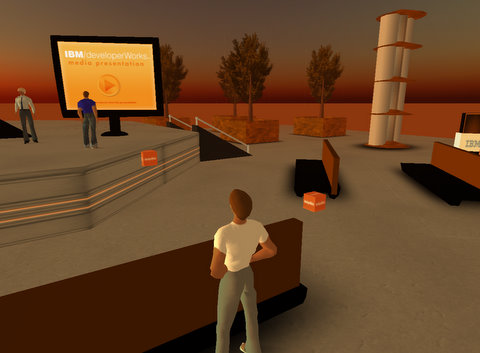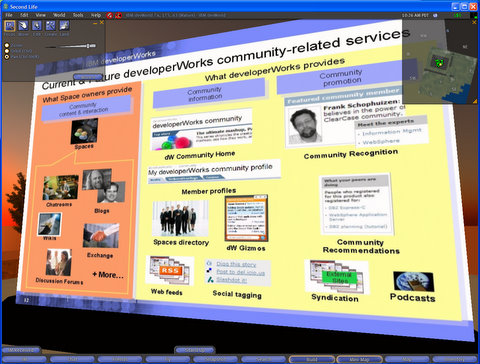IBM Strikes Out in Second Life
I left the real world yesterday to “attend” a technical briefing in Second Life, hosted by IBM, on what Web 2.0 means for business. I want to congratulate IBM for experimenting with virtual worlds. But in this case, the pretend physical nature of the online briefing detracted from the message and added nothing discernable. I spent more time fighting the Second Life client application than I did listening to the IBM presenters.

My generically clad avatar looks
at the right side of the virtual stage
during
IBM’s technical briefing.
The technical briefing had to begin a half-hour early to allow IBM and the two- or three-dozen attendees to work out the technical kinks, including the basics like learning to walk and sit in Second Life. For those who haven’t heard much about Second Life, it is a 3-dimensional online virtual world in which everyone is represented by a (usually) human-appearing image you can move around using the Second Life client application. The virtual world allows you to see and interact with real people who also are visiting Second Life. Second Life includes isolated islands and a mainland filled with various structures and objects created by Second Life owners and visitors.
Holding a meeting in a 3D virtual world promises new tools for collaboration. You could hold a main meeting, break out into smaller groups as needed while still easily rejoining the main group, share notes, share software, demo software on a virtual computer in the virtual world, and draw on whiteboards that can be stretched to fit your needs, using colored pens that never run dry. I’m unsure what capabilities Second Life provides today to do any of these things, but I don’t think talking is one of them. Attendees to the IBM session had to dial a regular conference telephone line to hear the presenters.
I say IBM struck out by holding this technical briefing in Second Life because the presenters merely talked, showed slides, and provided handouts. You don’t need a 3D virtual world to do these things. The bad part was Second Life detracted from the actual content of the briefing by having to deal with virtual-world activities instead of merely listening, reading and thinking.
First, I had trouble finding the conference room. The coordinates IBM provided took me to what looked like a sand-dune filled desert with a beautiful virtual sunset on the horizon. The only other thing I could see was one or two other virtual attendees walking around aimlessly. Flapping my arms eventually got me there. You see, the presentation was held on a platform floating in space above the ground. You had to fly up several meters to see it. (In Second Life you can fly.) Strike one.
Second, the Second Life client isn’t very stable. It froze and crashed while I was trying to move around. Strike two.

Here is me trying to view the slides in Second Life.
I captured this screenshot when
the slide was in focus.
Third, it was difficult to view the slides in Second Life. I first had to figure out what keystrokes I needed to zoom my vision onto the virtual projector screen. When I mastered that skill, I discovered the slides took a long time on my (fairly powerful) PC to paint and focus. Sometimes the slide would just start to appear on my screen as the presenter moved onto the next slide, which would blank out the slide I was frantically trying to read, and then the next slide would take 5 to 10 seconds to start painting on my virtual screen. Strike three.
Fourth, Second Life forces you to create a new name for yourself while visiting. You can choose a first name, but you have to choose from a list of Second Life family names. As a result, you can’t tell who the IBM speaker at the podium is without someone translating that “Foobar Frobney” (or whatever) is really IBM employee Alfredo Gutierrez. Strike, um, three and a half.
Even though Second Life’s virtual-world wasn’t the best forum for this technical briefing, I want to give IBM credit for trying. Virtual reality holds promise for providing better, more natural tools for online collaboration than simple slideshows and telephone conference lines. However, IBM will need to learn to use the best tool for the job. If you are just going to talk and show slides, there are more effective technologies today than Second Life.